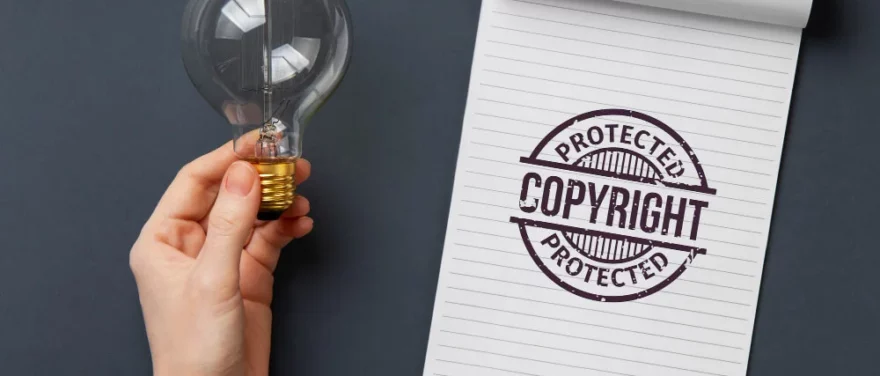
As a creative, you’ve poured your heart into your work, but have you protected it from online theft? Intellectual property rights are key to ensuring your creations stay safe and solely yours. Our guide is packed with practical steps to shield your art from unauthorised eyes and hands. Dive in for peace of mind.
Understanding Intellectual Property
Understanding intellectual property is crucial for creatives. It involves knowing what intellectual property is and the types of protections available, such as copyrights, patents, and trademarks.
What Is Intellectual Property?
Intellectual property, or IP for short, is the legal concept that covers creations of the mind. These can include designs, inventions, literary and artistic works, as well as symbols, names and images used in commerce.
Just like physical property can be bought or sold, so can intellectual property rights; they allow creators to profit from their own mental labours. These laws are crucial; they make sure that inventors and artists get recognition for their work and encourage more innovation and creativity.
Copyrights play a key role here by safeguarding original literary and artistic pieces such as books, music scores, paintings and photographs. Patents protect new inventions; think of them as a 20-year monopoly on an innovative product or process that solves specific problems.
Trademarks keep company brands unique by defending logos, slogans or distinctive signs in business operations against imitation. As digital content grows with social media’s rise to fame among creatives across all fields – graphic design included – these protections become even more important. They stop the unauthorised use of digital assets so that only those who create them have control over the reproduction or alteration of their work.
Types of Intellectual Property Protections for Creatives (Copyrights, Patents, Trademarks)
- Copyright protection allows creators to safeguard their creative expressions, such as original prints, patterns, and colour arrangements, from unauthorised use or appropriation.
- Patents provide legal protection for unique and novel inventions or processes created by individuals, ensuring that others cannot reproduce or profit from their original ideas without permission.
- Trademarks offer protection for brand names, logos, and symbols used to distinguish a creator’s products or services in the marketplace, preventing others from using identical or confusingly similar marks.
- Protecting digital content is crucial for influencers, and artists can utilise both trademarks and copyrights to safeguard their digital creations from unauthorised use and ensure legal rights over their work.
- It’s important for creatives to understand the different strategies offered by trademarks, copyrights, and patents in order to choose the most suitable protection for their creations and maintain control over their original works.
How to Protect Your Intellectual Property
Registering your work with the appropriate authorities is crucial for protecting your intellectual property. Finding good legal counsel and staying educated on IP protection will also help safeguard your creative work from unauthorised use.
Registering Your Work
To ensure the protection of your creative work, it is important to register it with the appropriate intellectual property authorities. Here are the steps to take:
- Research and identify the correct intellectual property office or agency in your country.
- Complete the necessary application forms and provide all required documentation.
- Pay the applicable fees to register for your work.
- Keep thorough records of your registration confirmation and any correspondence from the intellectual property office.
- Display copyright notices on your work, including your name, the copyright symbol (©), and the year of creation.
Finding Good Legal Counsel
When seeking legal counsel to protect your intellectual property, consider lawyers with expertise in copyright, trademark, and patent law. Look for professionals who understand the unique challenges faced by creatives and can provide tailored advice to protect your digital content.
It’s essential to find legal support that can help with registering your work and navigating any potential infringements. Additionally, seek out recommendations from other creators or industry associations to ensure you find a lawyer who understands the specific needs of artists and creators in the online space.
As you explore ways to safeguard your digital creations through intellectual property protection, it’s crucial to understand how legal counsel plays a key role in ensuring that your work receives the necessary legal protections.
Education on IP Protection
Understanding the complexities of intellectual property (IP) protection is crucial for creators. There are various types of IP, including copyrights, patents, and trademarks. Educating yourself on these protections can help you safeguard your original works from unauthorised use or appropriation.
Copyright laws specifically protect the expressions of creative ideas such as original prints, patterns, and colour arrangements. This knowledge empowers creators to have legal safeguards in place to maintain control over their digital content and assets.
Knowing how to navigate intellectual property rights is essential for both seasoned professionals and emerging talents in creative fields. Understanding the different aspects of IP protection allows individuals to make informed decisions about registering their work and utilising legal mechanisms to protect against infringement.
Keeping Organised and Thorough Documentation
Organising and maintaining detailed records is vital for protecting your intellectual property. Consistently documenting the creation, development, and ownership of your work helps establish legal proof of ownership. This documentation should include dates, versions, and any correspondence related to the creation process.
Thorough documentation plays a crucial role in defending against potential copyright or trademark disputes. By keeping organised records of your original creations and their evolution, you are better positioned to prove authorship if legal conflicts arise.
Protecting Your Artwork Online
Utilise online tools and services to track and monitor the use of your artwork while also respecting the intellectual property rights of others. To learn more about protecting your digital content online, continue reading this guide for creatives.
Utilising Online Tools and Services
- Search for online intellectual property tracking services
- Consider using digital asset management platforms to protect your artistic creations
- Utilise copyright infringement detection tools to safeguard your content from unauthorised use
- Explore trademark protection services to secure your brand identity online
Respecting the IP Rights of Others
Educating oneself on intellectual property rights is crucial, especially when utilising online tools and services. Acknowledging the IP rights of others ensures that individuals do not infringe on someone else’s creative work. It can prevent legal conflicts and protect against unauthorised use or appropriation of digital content.
Understanding copyright laws, trademarks, and patents can help creators respect others’ intellectual property. Being aware of these protections allows for a better understanding of how to safeguard one’s own original work while also respecting the creations of others.
Ensuring Your Contracts Protect Your Art

Ensure that your contracts with clients and collaborators include clear language on intellectual property rights, outlining who owns the rights to the work and how it can be used. To learn more about protecting your art through contracts, continue reading our guide for creatives.
Understanding IP Rules for Popular Social Media Platforms
It is essential for creators to understand the intellectual property (IP) rules on popular social media platforms. Here’s how you can ensure your work is protected:
- Familiarise yourself with the IP policies of each platform where you share your content. Make sure you understand how your work will be used and what rights you retain.
- Take advantage of the reporting tools provided by social media platforms to address any unauthorised use of your work.
- Regularly monitor your content for potential infringement and take swift action if necessary.
- Consider watermarking or adding copyright notices to your digital creations to establish ownership and deter misuse.
- Engage with other creators and stay informed about any changes in IP policies on different platforms.
The Future of Protecting Your Digital Content on Social Media

The future of protecting your digital content on social media involves being proactive and staying informed about changes in IP laws. This includes steps to protect your digital content, how to register a trademark and copyright, and further reading and resources for protecting your IP.
Steps to Protect Your Digital Content
To protect your digital content, it is important to follow these steps:
- Register for copyright protection to establish your ownership and rights over your creations.
- Utilise online tools and services that can help monitor and track unauthorised use of your digital content.
- Stay updated on intellectual property laws and regulations to ensure you are aware of your legal rights as a creator.
- Consider using watermarking or digital signatures on your artwork to deter unauthorised use and establish ownership.
- Regularly review and update your security measures for online platforms where your digital content is uploaded or shared.
How to Register a Trademark and Copyright
To register a trademark and copyright, follow these steps:
- Research existing trademarks and copyrights to ensure your creation is unique.
- Complete the trademark and copyright application forms with accurate and detailed information.
- Pay the necessary fees for the registration process.
- Keep thorough documentation of all correspondence related to your application.
- Once registered, regularly monitor for any unauthorised use or infringement of your trademarks and copyrights.
Further Reading and Resources for Protecting Your IP
Explore comprehensive resources on protecting your intellectual property (IP). Learn about the different types of IP protection, including copyrights, patents, and trademarks. Understand the legal safeguards available to creators for their original works online.
Access useful guides and tools for tracking and protecting digital content. Familiarise yourself with strategies to detect unauthorised use of your work and maintain control over your original creations. Stay informed about intellectual property law to protect your art from online piracy. Find valuable information on brand protection and upholding your legal rights as a creator in the digital space.
In conclusion, protecting your intellectual property online is essential for creatives. Understanding and utilising trademarks, copyrights, and patents can safeguard your digital content from unauthorised use. Educating yourself on intellectual property rights and getting legal counsel are crucial steps in maintaining control over your original works. Utilising online tools for tracking and respecting the IP rights of others will help protect your artwork from online piracy.
